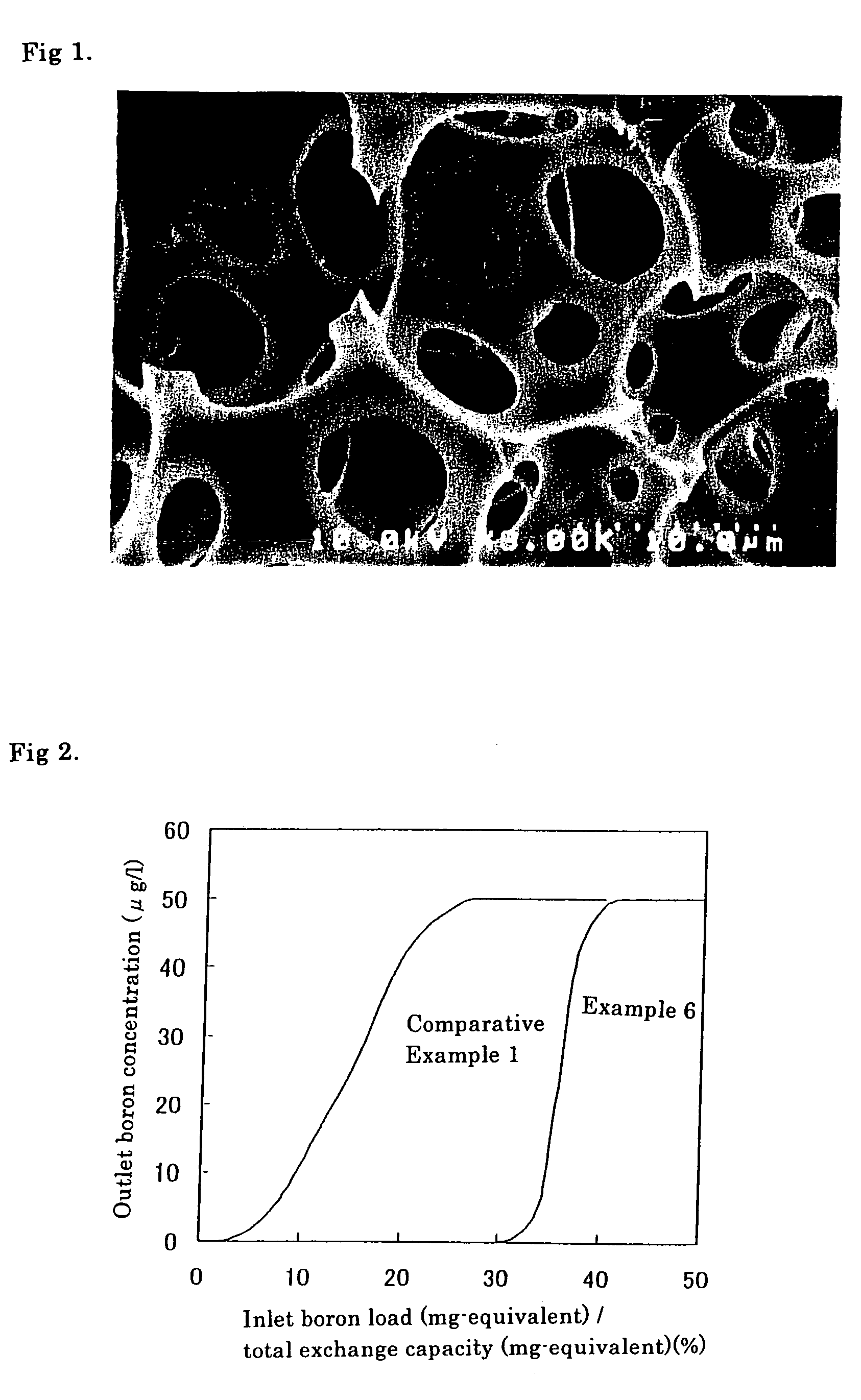Organic porous article having selective adsorption ability for boron, and boron removing module and ultra-pure water production apparatus using the same
a technology of organic porous articles and selective adsorption, which is applied in the direction of filtration separation, other chemical processes, separation processes, etc., can solve the problems of insufficient ability of selective adsorption resin, insufficient ability of selective adsorption of boron, and inability to remove boron by reverse osmosis membrane, etc., to achieve high efficiency, specific surface area, and maintain strength
- Summary
- Abstract
- Description
- Claims
- Application Information
AI Technical Summary
Benefits of technology
Problems solved by technology
Method used
Image
Examples
example 1
(Preparation of Organic Porous Material)
[0038]Chloromethylstyrene (19.24 g), divinylbenzene (1.01 g), sorbitan monooleate (2.25 g), and azobisisobutyronitrile (0.26 g) were mixed and homogeneously dissolved. The chloromethylstyrene / divinylbenzene / sorbitan monooleate / azobisisobutyronitrile mixture was added to deionized water (180 g). The mixture was stirred using a planet-type stirrer (vacuum agitation defoaming mixer, manufactured by EME Co., Ltd.) at a reduced pressure of 13.3 kPa, at a revolution rate (rotation around a revolution axis) of 1,800 rpm / min, and at a rotation of 600 rpm / min for 2.5 minutes to obtain a water-in-oil emulsion. After the emulsification, the reaction system was sufficiently displaced with nitrogen and the emulsion was allowed to stand at 70° C. for 24 hours to polymerize. After the polymerization, the reaction mixture was extracted with isopropanol for 18 hours using a Soxhlet extractor to remove the unreacted monomers, water, and sorbitan monooleate. The...
examples 2 – 5
Examples 2–5
(Preparation of Organic Porous Material)
[0042]An organic porous material was produced in the same manner as in Example 1, except for changing the amounts of chloromethylstyrene, divinylbenzene, sorbitan monooleate, and azoisobutylonitrile as shown in Table 1.
(Reaction of Compound Forming Complex with Boric Acid with Organic Porous Material)
[0043]An organic porous material capable of selectively adsorbing boron was produced in the same manner as in Example 1, except that the organic porous material was reacted with N-methyl-D-glucamine in an amount shown in Table 2. The results are shown in Table 2. In these Examples, the amount of introduced N-methyl-D-glucamine determined by elemental analysis showed good agreement with the ion exchange capacity.
(Preparation of Column for Evaluating Adsorption of Boron and Water Passage Experiment Using Same)
[0044]The same water passage experiment using the column for evaluating adsorption of boron as prepared in the same manner as in E...
example 6
(Preparation of Column for Evaluating Adsorption of Boron and Water Passage Experiment Using Same)
[0047]A column for evaluating adsorption of boron was prepared by the method described in Example 1, except for using a column with a length of 300 mm. Except for using this column, the same water passage experiment for a boron aqueous solution as in Example 1 was carried out to obtain a boron breakthrough curve. The results are shown in FIG. 2. The proportion of the inlet boron load to the total ion exchange capacity in the column until the boron concentration in the outlet water exceeded 1 μg / l, that is, utilization efficiency of a functional group, was 31%. The same proportion until the boron concentration in the outlet water became equal to the boron concentration in the inlet water was 42%.
PUM
| Property | Measurement | Unit |
|---|---|---|
| pore diameter | aaaaa | aaaaa |
| pore diameter | aaaaa | aaaaa |
| pore diameters | aaaaa | aaaaa |
Abstract
Description
Claims
Application Information
 Login to View More
Login to View More - R&D
- Intellectual Property
- Life Sciences
- Materials
- Tech Scout
- Unparalleled Data Quality
- Higher Quality Content
- 60% Fewer Hallucinations
Browse by: Latest US Patents, China's latest patents, Technical Efficacy Thesaurus, Application Domain, Technology Topic, Popular Technical Reports.
© 2025 PatSnap. All rights reserved.Legal|Privacy policy|Modern Slavery Act Transparency Statement|Sitemap|About US| Contact US: help@patsnap.com


